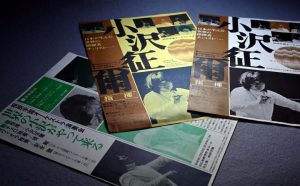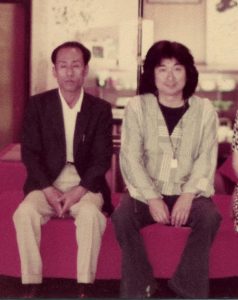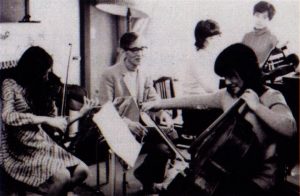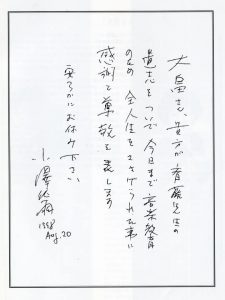Seiji Ozawa and A-bombed Hiroshima, Part 2: School for children serves as bond
Aug. 7, 2024
Concept of Hiroshima as venue for Saito Kinen Festival
by Miho Kuwajima, Staff Writer
In the 1970s and ‘80s, Seiji Ozawa would frequently visit Hiroshima to conduct orchestras. In interviews with those involved about his motivations for doing so, one person repeatedly came to the fore. That was Hiroto Obatake (1926–1998), an ardent admirer of Ozawa’s mentor Hideo Saito (1902–1974). Mr. Obatake devoted his life to music education in Hiroshima.
Mr. Obatake was from Hatsukaichi City. After returning from the battlefield in 1946, he started work as an engineer for the Chugoku Electric Power Company. Around that time, the cellist Hideo Saito and the pianist Motonari Iguchi (1908–1983) visited the incinerated ruins of Hiroshima for a performance designed to provide comfort to the local citizenry. Mr. Obatake was touched by the sounds and tones of the music played at the performance.
Moreover, when he listened to interviews with and performances by the music school taught by Mr. Saito on the radio, Mr. Obatake was moved by the energy of the children. In Hiroshima, where reconstruction was underway, a dream was born for him.
Mr. Obatake repeatedly approached Mr. Saito directly about his idea. Although his requests for collaboration were rejected at first, he finally succeeded at opening the Hiroshima branch of the Toho Music School for Children in 1963 by renting space at the Aki Kindergarten, located in the city’s Minami Ward. The school was relocated to the Hiroshima Christian Church in the city’s Naka Ward in 1968, where full-scale operations of the school began.
Mr. Saito, who came to trust Mr. Otake’s passion, sent to the Hiroshima branch school a succession of up-and-coming musicians at the time, including the pianist Minoru Nojima and violinist Teiko Maehashi. “Mr. Obatake would arrange overnight train tickets and accommodations. He also invested his own money into running the school,” recalled Yuko Oshimo, 59, a student at the school who later taught in the school’s piano program for many years.
At its peak in the 1980s, more than 100 students from the Chugoku and Shikoku regions of Japan were enrolled in the school. Hisaya Dogin, 64, who joined the school at the age of 10 and later performed as a cellist with the NHK Symphony Orchestra for more than 30 years, remembered Mr. Obatake in the lesson room on his off days. “He was so passionate it was almost frightening. He would always try and push the students by telling them they needed to practice more,” said Mr. Dogin.
“I want children in Hiroshima to listen to authentic performances.” With that idea, Mr. Obatake aimed to produce concerts, inviting numerous orchestras of renown to Hiroshima, including the Toho Gakuen School of Music Orchestra in December 1973, the first time for Mr. Ozawa to conduct in Hiroshima. Mr. Obatake was involved in all aspects of the concert, including the designs of the posters and programs.
“Each and every movement of Mr. Ozawa sparkled and dazzled. It would be like today’s baseball-loving boys watching Shohei Ohtani,” recalled Kazufumi Yamashita, 62, a conductor from Hiroshima and a professor at the Tokyo University of the Arts. He was in the sixth grade at Hesaka Elementary School at the time and studied the cello at the music school’s Hiroshima branch.
Mr. Saito frequently visited Hiroshima to give cello lessons, among other reasons. In August 1974, around three weeks before his death, he gave a lecture on music theory in Hiroshima despite enduring the last stages of cancer.
In honor of Mr. Saito’s achievements, his students initiated the Saito Kinen Festival Matsumoto (present-day Seiji Ozawa Matsumoto Festival) in Matsumoto City, Nagano Prefecture, in 1992. Mr. Ozawa, the one who had first come up with the idea, originally had the idea of having Hiroshima serve as the festival venue. Approached by Mr. Ozawa, Mr. Obatake negotiated with both Hiroshima prefectural and city officials numerous times, all in vain. “I can’t forget the sight of Mr. Obatake as he lamented, ‘it’s so frustrating,’” said Harumi Kakura, 84, a resident of Hiroshima’s Nishi Ward and a piano tuner who supported the Hiroshima Music School for more than 50 years.
On August 20, 1998, Mr. Obatake died at the age of 71, just as the festival was being held in Matsumoto. Mr. Ozawa sent a handwritten tribute in remembrance of Mr. Obatake, who he said, “devoted his entire life to music education.”
Keywords
Hideo Saito
Born in Tokyo, Hideo Saito was a cellist, conductor, and music educator. In 1948, he established the Music School for Children in Tokyo, the predecessor to the Toho Gakuen School of Music. He served as a professor at the Toho Gakuen School of Music and dean of Toho Gakuen Junior College. He mentored Mr. Ozawa and Kazuyoshi Akiyama, a lifetime conductor emeritus of the Hiroshima Symphony Orchestra, among others.
(Originally published on August 7, 2024)











